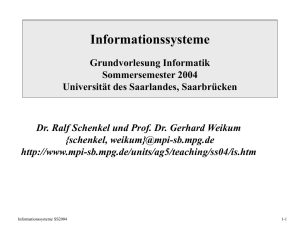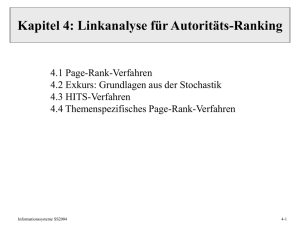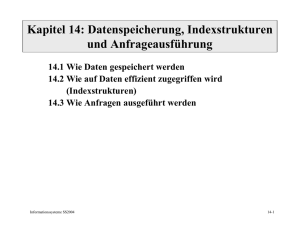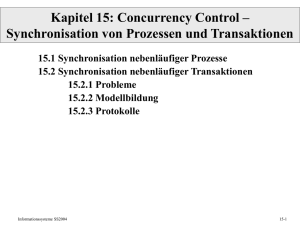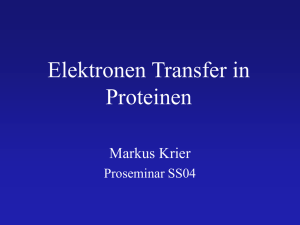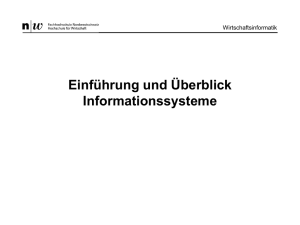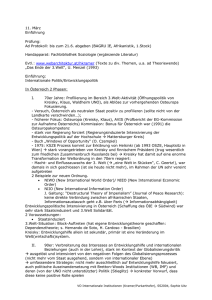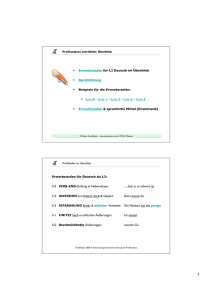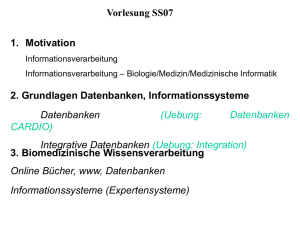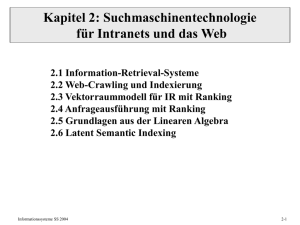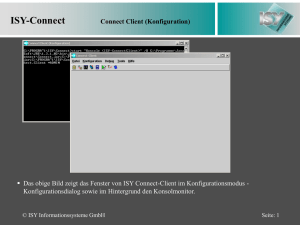F,!Fok,!Eok
Werbung
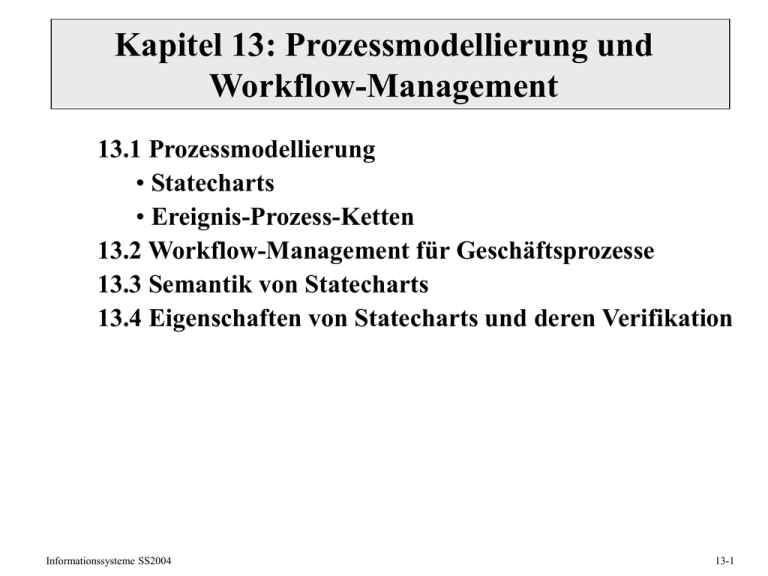
Kapitel 13: Prozessmodellierung und
Workflow-Management
13.1 Prozessmodellierung
• Statecharts
• Ereignis-Prozess-Ketten
13.2 Workflow-Management für Geschäftsprozesse
13.3 Semantik von Statecharts
13.4 Eigenschaften von Statecharts und deren Verifikation
Informationssysteme SS2004
13-1
Workflow Application Example 1:
Credit Request Processing
Enter
Credit
Request
Check
Credit
Worthiness
Make
Decision
Check
Risk
Informationssysteme SS2004
13-2
Workflow Application Example 2:
Journal Refereeing Process
Choose
referees
Contact
referee 1
Send
paper
Contact
referee 2
...
Contact
referee 3
Receive
submitted
paper
Informationssysteme SS2004
...
Remind
referee 1
Receive
review 1
Make
editorial
decision
Notify
author
13-3
What is Workflow Management?
Computer-supported business processes:
coordination of control and data flow between
distributed - automated or intellectual - activities
Application examples:
Credit requests, insurance claims, etc.
Tax declaration, real estate purchase, etc.
Student exams, journal refereeing, etc.
Electronic commerce, virtual enterprises, etc.
Informationssysteme SS2004
13-4
Business Benefits of
Workflow Technology
Business process automation
(to the extent possible and reasonable)
shorter turnaround time, less errors,
higher customer satisfaction
better use of intellectual resources
for exceptional cases
Transparency
understanding & analyzing the enterprise
Fast & easy adaptation
Business Process Reengineering (BPR)
Informationssysteme SS2004
13-5
13.1 Specification Method and Environment
Requirements:
•
•
Visualization
Refinement &
Composability
Solutions:
Statecharts (Harel et al. 1987)
(alt.: Petri Net variants,
temporal logic, process algebra,
script language)
•
•
Rigorous Semantics
Interoperability with
other methods & tools
Import / export
BPR tools WFMS WFMS
•
Wide acceptance &
standard compliance
Statecharts included in
UML industry standard
(Unified Modeling Language,
OMG 1997))
Informationssysteme SS2004
13-6
Informationssysteme SS2004
13-7
Informationssysteme SS2004
13-8
Informationssysteme SS2004
13-9
Activitychart Example 1
Kundendaten
KREDIT_AC
DE
Kundendaten
Kundendaten
Informationssysteme SS2004
KW
RSK
Kundendaten
ENT
ERROR
13-10
Statechart Example 1
KREDIT_SC
DE_S
[DE_OK and
not (Betrag < 1000]
INIT_S
KR_S
KW_S
RSK_S
[KW_OK and
RSK_OK]]
ENT_S
[ENT_OK]
[DE_OK
and
Betrag < 1000]
[DE_NOK or
KW_NOK or
RSK_NOK or
ENT_NOK or]
ERROR_S
FINI_S
Informationssysteme SS2004
13-11
Statechart Example 2
/ Budget:=1000;
Trials:=1;
Select
Conf
CheckConfFee
Check
Flight
Select
Tutorials Compute
Fee
[Found]
/ Cost:=0
[!Found]
Go
[Cost Budget]
Check
Cost
Check
Airfare
Check
Hotel
Check
Hotel
[Cost > Budget
[Fok & Eok] & Trials 3]
/ Cost :=
ConfFee +
TravelExpenses
No
CheckTravel
Expenses
[Cost > Budget &
Trials < 3] / Trials++
Informationssysteme SS2004
13-12
E-Commerce Workflow: Activitychart
Versandhaus_AC
Kreditkartennummer, Betrag, ...
KreditkartePrüfung_ACT
Bestellung_ACT
Kreditkartennummer, Betrag, ... KreditkartenBelastung_ACT
E-Mail_ACT
Bestellnummer, e-mail-Adr., ...
Name, Adresse,
Bestellnummer, ...
Bestellnummer,
Bestellliste, ...
Bezahlung_ACT
@Versandhaus_SC
Informationssysteme SS2004
LagerErmittlung_ACT
Versandgarantie
Lieferanschrift, ...
LagerID,
Bestellliste,
...
LagerInstruierung_ACT
13-13
E-Commerce Workflow: Statechart
Versandhaus_SC
Versandhaus_INIT_S
/st!(Bestellung_ACT)
Bestellung_S
[Bestellung_DONE and
Rechnungszahlung]
[Bestellung_DONE and
KreditkartenZahlung]
/st!(KreditkartenPrüfung_ACT)
Bestätigung_SC
[in(Bestätigung_EXIT_S) and
in(Versand_EXIT_S) and
Rechnungszahlung]
/st!(Bezahlung_ACT)
Bezahlung_S
Informationssysteme SS2004
[ZahlungEingegangen]
[KreditkarteOK and
KreditkartenPrüfung_DONE]
[KreditkartenFehler]
Lieferung_S
KreditkartenPrüfung_S
Versand_SC
[... KreditkartenZahlung]
/st!(KreditkartenBelastung_ACT)
KreditkartenBelastung_S
[KreditkartenBelastung_DONE]
Versandhaus_EXIT_S
13-14
E-Commerce Sub-Workflows
Bestätigung_SC
Bestätigung_INIT_S
/st!(E-Mail_ACT)
Versand_SC
Versand_INIT_S
/st!(LagerErmittelung_ACT)
[VersandGarantiert]
LagerErmittlung_S
E-Mail_S
[LagerErmittelt]
/fs!(VersandGarantiert)
st!(LagerInstruierung_ACT)
[E-Mail_DONE]
Bestätigung_EXIT_S
Informationssysteme SS2004
LagerInstruierung_S
[AllesAbgeschickt]
Versand_EXIT_S
13-15
Ereignis-Prozeß-Ketten (EPKs) (1)
Bedingung
Ereignis
Akteur
(Stelle,
Rolle)
InputDaten
Tätigkeit
Funktion
(Aktion)
OutputDaten
Informationssysteme SS2004
13-16
Ereignis-Prozeß-Ketten (EPKs) (2)
Funktion
Bedingung 1
Ereignis 1
Funktion
Bedingung 2
Ereignis 2
...
Informationssysteme SS2004
Verzweigung
Ereignis 2
...
...
...
Ereignis 1
(ForkJoin-)
Split
13-17
Start
EPK-Beispiel
DE
DE_OK
Betrag
< 1000
Betrag
1000
KW
RSK
KW_OK
RSK_OK
Informationssysteme SS2004
ENT
13-18
Import from BPR Tools
Event process chains
(EPCs à la Aris Toolset):
- process decomposed into functions
- completed functions raise events
that trigger further functions
- control-flow connectors
Informationssysteme SS2004
13-19
Import from BPR Tools (continued)
Informationssysteme SS2004
13-20
13.2 Workflow Management
System Architecture
Workflow
specification
Workflow server
...
Informationssysteme SS2004
Activities / Applications
13-21
WfMC Reference Architecture
Workflow
Management
System
(WFMS)
Administration
& Monitoring
Tools
Process
Definition
Tools
Workflow Engine
Workflow Enactment Service
Workflow
Client
Applications
Informationssysteme SS2004
Other WF
Enactment
Services
Invoked
Applications
13-22
13.3 Abstract Syntax of Statecharts (1)
A
B
J
C
D
E
L
F
G
K
H
M
State set S
State tree (with node types AND or XOR)
Transition t: (source, target, [c]/a)
Transition set T
Variable set V
Informationssysteme SS2004
13-23
Abstract Syntax of Statecharts (2)
A
B
C
E
XOR
Informationssysteme SS2004
XOR
J
AND
F
XOR
D
XOR
XOR
G
K
L
XOR
M
XOR XOR XOR
H
XOR
XOR
13-24
Operational Semantics of Statecharts (1)
Execution state of statechart (S,T,V):
subset states S of currently active states s.t.
• root of S is in states
• if s in states and type of s is AND then all children of s are in states
• if s in states and type of s is XOR
then exactly one child of s is in states
Execution context of statechart (S,T,V):
current values of variables defined by val: V Dom
Configuration of statechart (S,T,V): (states, val)
Initial configuration
Informationssysteme SS2004
13-25
Operational Semantics of Statecharts (2)
Evaluation of expression in configuration:
eval (expr, conf) defined inductively
Effect of action on context:
modification of variable values in val
fire(conf) = set of transitions
t = (source, target, [cond]/action)
with source(t) in states for which eval(cond, conf) = true
Informationssysteme SS2004
13-26
Operational Semantics of Statecharts (3)
for transition t:
• a = lca (source(t), target(t))
• src(t) = child of a in subtree of source(t)
• tgt(t) = child of a in subtree of target(t)
when t fires:
• set of left states source*(t):
• src(t) is in source*(t)
• if s in source*(t) then all children of s are in source*(t)
• set of entered states target*(t):
• tgt(t) and target(t) are in target*(t)
• if s in target*(t) and type of s is AND
then all children of s are in target*(t)
• if s in target*(t) and type of s is XOR
then exactly one child of s with initial transition is in target*(t)
Informationssysteme SS2004
13-27
Operational Semantics of Statecharts (4)
For a given configuration conf = (states, val) a
successor configuration conf‘ = (states‘, val‘) is derived
by selecting one transition t from fire(conf) with the effect:
• states‘ = states – source*(t) target*(t)
• val‘ captures the effect of action(t) and equals val otherwise
The operational semantics of a statechart (S,V,T) is the
set of all possible executions along configurations
conf0, conf1, conf2, ... with
• initial configuration conf0 and
• confi+1 being a successor configuration of confi
Informationssysteme SS2004
13-28
Digression: Finite State Automata
Definition:
Ein endlicher Automat (finite state automaton) ist ein 5-Tupel
M = (Z, , , z0, E) mit
einer endlichen Zustandsmenge Z
einem Alphabet (d.h. einer endlichen Menge von Zeichen)
einer Transitionsfunktion : Z Z
einem Startzustand z0
einer Menge von Endzuständen E Z
M geht in z Z mit Eingabe x in (z,x) Z über.
wird homomorph zur Funktion *: Z * Z erweitert:
*(z, au) = *( (z,a),u) mit zZ, a, u *.
Die Menge L(M) = {w * | *(z0,w) E} *
ist die vom Automat M akzeptierte Sprache.
Informationssysteme SS2004
13-29
FSA Example 1
beliebige
Zeichen
andere Zeichen
Fehler
+, –
Vorzeichen
0
Start
0
Null
0 .. 9
.
Punkt
1 .. 9
Mantisse
E
+, –
Vorzeichen
Informationssysteme SS2004
E
1 .. 9
1 .. 9
0 .. 9
Exponent
13-30
FSA Example 2
{F,W,Z,K}
FK
{W,Z}
FZ
{F,K}
FW
FZ
{Z,K} {F,W}
{W,K} {F,Z}
...
...
F
{F,W,K}
{Z}
FW
FK
{K} {F,W,Z}
{W} {F,K,Z}
FZ
FZ
{F,K,Z}
{W}
{F,W,Z}
FK
{K}
FW
{Z}
{F,W,K}
F
{F,Z}
FZ
Informationssysteme SS2004
{W,K}
{F,W,Z,K}
13-31
Mapping Statecharts into FSAs
Represent SC configurations as states of a FSA:
Step 1:
abstract conditions on infinite-domain variables into Boolean vars
formal mapping: 1: val B1 B2 ... Bm
Step 2:
capture set of active SC states (in SC hierarchy and in components)
by powerset automaton 2: states 2S =: Z
Step 3:
encode SC context into extended state space of FSA
by an injective mapping 3: Z B1 B2 ... Bm Z’
such that there is a transition from z1 to z2 in the FSA
iff 3-1(z2) is a possible successor configuration of 3-1(z1) in the SC
Informationssysteme SS2004
13-32
Example: From SC To FSA (1)
/ Budget:=1000;
Trials:=1;
Select
Conf
CheckConfFee
Check
Flight
Select
Tutorials Compute
Fee
[Found]
/ Cost:=0
[!Found]
Go
[Cost Budget]
Check
Cost
Check
Airfare
Check
Hotel
Check
Hotel
[Cost > Budget
[Fok & Eok] & Trials 3]
/ Cost :=
ConfFee +
TravelExpenses
No
CheckTravel
Expenses
[Cost > Budget &
Trials < 3] / Trials++
Informationssysteme SS2004
13-33
Example: From SC To FSA (2)
4
1
SelectConf,
!F,!Fok,!Eok,
!Bok,Tok
3
...
CheckConfFee,
CheckTravelExpenses,
F,!Fok,!Eok,
Bok,Tok
CheckCost,
F,Fok,Eok,
Bok,Tok
8
5
Go,
F,Fok,Eok,
Bok,Tok
6
9
CheckCost,
F,Fok,Eok,
Bok,!Tok
CheckCost,
F,Fok,Eok,
!Bok,!Tok
No,
F,Fok,Eok,
!Bok,!Tok
7
2
CheckCost,
F,Fok,Eok,
!Bok,Tok
No,
!F,!Fok,!Eok,
!Bok,Tok
Informationssysteme SS2004
13-34
13.4 Guaranteed Behavior and Outcome
of Mission-critical Workflows
Crucial for workflows in
banking, medical applications, electronic commerce, etc.
• Safety properties (invariants):
nothing bad ever happens
• Liveness properties (termination, fairness, etc.):
something good eventually happens
Mathematical model
Finite-state automaton
Formalization of properties
Temporal logic
Verification method
Model checking
Informationssysteme SS2004
13-35
CTL: Computation Tree Logic
propositional logic formulas
quantifiers ranging over execution paths
modal operators referring to future states
all
next:
exists
next:
all
globally:
AX p
EX p
AG p
all finally exists
(inevitably): globally:
AF p
EG p
exists finally
(possibly):
EF p
combination:
EF AG p
Informationssysteme SS2004
13-36
Critical Properties of the Example Workflow
formalized in CTL (Computation Tree Logic)
Can we ever exceed the budget ?
not EF ( in(Go) and !Bok )
AG ( not in(Go) or Bok )
Do we always eventually reach a decision ?
AF ( in(Go) or in(No) )
Can the trip still be approved after a proposal
that would have exceeded the budget ?
EF ( (in(CheckCost) and !Bok) => ( EF (in(Go)) ) )
Informationssysteme SS2004
13-37
CTL Syntax
Definition:
Eine atomare CTL-Formel ist eine aussagenlogische Formel
über elementaren Aussagen (bzw. Booleschen Variablen).
Die Menge der in CTL erlaubten Formeln ist induktiv
wie folgt definiert:
• Jede atomare CTL-Formel ist eine Formel.
• Wenn P und Q Formeln sind, dann sind auch
EX (P), AX (P), EG (P), AG (P), EF (P), AF (P),
(P), P, PQ, PQ, PQ und PQ Formeln.
Informationssysteme SS2004
13-38
CTL Semantik (1)
Definition:
Gegeben sei eine Menge P atomarer aussagenlogischer Formeln.
Eine Kripke-Struktur M über P ist ein 4-Tupel (S, s0, R, L) mit
• einer endlichen Zustandsmenge S,
• einem Startzustand s0 S,
• einer Transitionsrelation R S S,
• einer Funktion L: S 2P, die einem Zustand wahre Aussagen
zuordnet.
Definition:
Eine Kripke-Struktur M = (S, s0, R, L) ist ein Modell einer Formel F,
wenn M,s0 |= F.
Eine Formel heißt erfüllbar, wenn sie mindestens ein Modell hat,
ansonsten unerfüllbar.
Eine Formel F heißt allgemeingültig (oder Tautologie), wenn jede
Kripke-Struktur über den atomaren Aussagen von F
ein Modell von F ist.
Informationssysteme SS2004
13-39
CTL Semantik (2)
Definition:
Die Interpretation einer Formel F mit atomaren Aussagen P ist eine
Abbildung auf eine Kripke-Struktur M=(S, s0, R, L) über Aussagen P,
so dass die Wahrheitswerte von Teilformeln p bzw. p1, p2 von F
in den Zuständen s von M, in Zeichen: M,s |= p, wie folgt sind:
(i) M,s |= p mit einer aussagenlogischen Formel p gilt g.d.w. p L(s);
(ii) M,s |= p g.d.w. nicht M,s |= p gilt;
(iii) M,s |= p1 p2 g.d.w. M,s |= p1 und M,s |= p2;
(iv) M,s |= p1 p2 g.d.w. M,s |= p1 oder M,s |= p2;
(v) M,s |= EX p g.d.w. es tS gibt mit (s,t)R und M,t |= p;
(vi) M,s |= AX p g.d.w. für alle tS mit (s,t)R gilt: M,t |= p;
(vii) M,s |= EG p g.d.w. es t1, ..., tk S gibt mit t1=s, (ti, ti+1)R für alle i und
tk=tj für ein j:1j<k oder tk ohne Nachfolger, so dass M,ti |= p für alle i;
(viii) M,s |= AG p g.d.w. für alle tS mit (s,t)R* gilt: M,t |= p;
(ix) M,s |= EF p g.d.w. es tS gibt mit (s,t)R* und M,t |= p;
(x) M,s |= AF p g.d.w. es für alle tS mit (s,t)R* einen Zustand t’S gibt
mit a) (t,t’)R* oder b) (s,t’)R* und (t’,t)R*, so dass M,t’ |= p gilt.
Informationssysteme SS2004
13-40
Model Checking
Für CTL-Formel F und Transitionssystem (Kripke-Struktur) M
teste, ob M ein Modell von F ist, indem man
induktiv alle Zustände von M mit q markiert, in denen
die Teilformel q von F wahr ist.
Sei q eine Teilformel von F, seien p, p1, p2 direkte Teilformeln von q
und seien P, P1, P2 die mit p, p1, p2 markierten Zustände von M.
(i) q ist eine atomare Aussage (Boolesche Variable):
Markiere alle Zustände s mit qL(s) mit q
(ii) q hat die Form p: Markiere S – P mit q
(iii) q hat die Form p1 p2: Markiere P1 P2 mit q
(iv) q hat die Form p1 p2: Markiere P1 P2 mit q
(v) q hat die Form EX p:
Markiere alle Vorgänger von P mit q, also alle sS,
für die es ein xP gibt mit R(s,x)
(vi) q hat die Form AX p:
Markiere s mit q, wenn alle Nachfolger von s mit p markiert sind
Informationssysteme SS2004
13-41
Model Checking: Fall EF
(vii) q hat die Form EF p:
Löse Rekursion EF p p EX (EF p).
(Fixpunktgleichung Q = P pred(Q) )
Q := P;
Qnew := Q pred(Q);
while not (Q = Qnew) do
Q := Qnew;
Qnew := Q pred(Q);
od;
Informationssysteme SS2004
13-42
Model Checking: Fall EG
(viii) q hat die Form EG p:
Löse Rekursion EG p p EX (EG p) :
Q := P;
Qnew := Q ;
repeat
for each s in Q do
if s has successors and
no successor of s is in Q
then Qnew := Q - {s}; fi;
od;
until (Q = Qnew);
Informationssysteme SS2004
13-43
Model Checking: Fall AG
(ix) q hat die Form AG p:
Löse Rekursion AG p p AX (AG p)
Q := P;
repeat
Qnew := Q;
for each s in Q do
if s has successors and
one successor of s is not in Q
then Q := Q - {s} fi;
od;
until (Q = Qnew);
Alternativ wegen AG p EF (p):
Berechne Zustandsmenge Q’ zur Formel EF (p)
und markiere dann die Zustandsmenge S – Q’ mit q.
Informationssysteme SS2004
13-44
Model Checking: Fall AF
(x) q hat die Form AF p:
Löse Rekursion AF p p AX (AF p)
Q := P;
repeat
Qnew := Q;
for each s in pred(Q) do
if all successors of s are in Q
then Q := Q {s}; fi;
od;
until (Q = Qnew);
Alternativ wegen AF p EG (p):
Berechne Zustandsmenge Q’ zur Formel EG (p)
und markiere dann die Zustandsmenge S – Q’ mit q.
Informationssysteme SS2004
13-45
Model Checking: Beispiel 1
AG ( not in(Go) or Bok )
1
SelectConf,
!F,!Fok,!Eok,
!Bok,Tok
3
...
CheckConfFee,
CheckTravelExpenses,
F,!Fok,!Eok,
Bok,Tok
4
CheckCost,
F,Fok,Eok,
Bok,Tok
5
CheckCost,
F,Fok,Eok,
Bok,!Tok
6
CheckCost,
F,Fok,Eok,
!Bok,!Tok
7
CheckCost,
F,Fok,Eok,
!Bok,Tok
8
Go,
F,Fok,Eok,
Bok,Tok
9
No,
F,Fok,Eok,
!Bok,!Tok
2
No,
!F,!Fok,!Eok,
!Bok,Tok
Markiere
mit Bok:
mit in(Go):
mit in(Go):
mit (Bok in(Go)):
mit AG (Bok in(Go)):
Informationssysteme SS2004
13-46
Model Checking: Beispiel 2
AF (in(Go) in(No))
1
SelectConf,
!F,!Fok,!Eok,
!Bok,Tok
3
...
CheckConfFee,
CheckTravelExpenses,
F,!Fok,!Eok,
Bok,Tok
4
CheckCost,
F,Fok,Eok,
Bok,Tok
5
CheckCost,
F,Fok,Eok,
Bok,!Tok
6
CheckCost,
F,Fok,Eok,
!Bok,!Tok
7
CheckCost,
F,Fok,Eok,
!Bok,Tok
8
Go,
F,Fok,Eok,
Bok,Tok
9
No,
F,Fok,Eok,
!Bok,!Tok
2
No,
!F,!Fok,!Eok,
!Bok,Tok
Markiere
mit in(Go):
mit in(No):
mit in(Go) in(No):
mit AF (in(Go) in(No)):
Informationssysteme SS2004
13-47
Model Checking: Beispiel 3
EF ( (in(CheckCost) and !Bok) => ( EF (in(Go)) ) )
1
SelectConf,
!F,!Fok,!Eok,
!Bok,Tok
3
...
CheckConfFee,
CheckTravelExpenses,
F,!Fok,!Eok,
Bok,Tok
4
CheckCost,
F,Fok,Eok,
Bok,Tok
5
CheckCost,
F,Fok,Eok,
Bok,!Tok
6
CheckCost,
F,Fok,Eok,
!Bok,!Tok
7
CheckCost,
F,Fok,Eok,
!Bok,Tok
8
Go,
F,Fok,Eok,
Bok,Tok
9
No,
F,Fok,Eok,
!Bok,!Tok
2
No,
!F,!Fok,!Eok,
!Bok,Tok
Markiere
mit in(Go):
mit EF (in(Go)):
mit not in(CheckCost) or Bok:
mit (in(CheckCost) and !Bok) => ( EF (in(Go)):
mit EF ( (in(CheckCost) and !Bok) => ( EF (in(Go)) ) ):
Informationssysteme SS2004
13-48
Guaranteed Behavior of Workflows
Leverage computer-aided verification techniques
for finite-state concurrent systems
Efficiency gain with encoding of FSM as OBDD
Further requirements:
- User-friendly macros for CTL
- More expressive logic
- Adding assertions on behavior of invoked apps
- Adding real-time (clock variables)
Preserving guaranteed behavior
in distributed, failure-prone system environment
System guarantees
Informationssysteme SS2004
13-49
